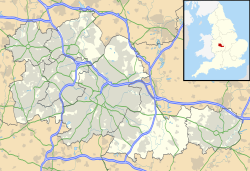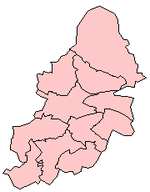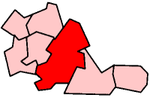Parish of Yardley
Yardley is not a town. The ancient parish of Yardley included the areas known as Stechford and Hall Green. Yardley is named in the Domesday Book and was referred to as early as 972 in King Edgar's Charter where it is named Gyrdleah. It was mentioned as being under the possession of Pershore Abbey. Yardley also contains a moated medieval site called "Kent's Moat". Now dry, it has retained its depth and shape remarkably well considering its age, as excavations have shown evidence of inhabitation from as early as the 12th century.
Yardley has a Tudor hall called Blakesley Hall and an old church, St Edburgha's, that dates back to the 13th century, with the church tower and spire dating to the 15th century. It was not established by the abbey, but by Aston Church in the Diocese of Lichfield. [4] A Tudor addition to the church is a doorway surrounded by Tudor roses and a pomegranate, commemorating the marriage of Prince Arthur, Prince of Wales, to Catherine of Aragon.
Yardley had a manor that was owned by various lords. It remained unoccupied from 1700 onwards. It was owned by the Royal Family until 1626, when it was bought by Richard Grevis of Moseley Hall. His descendants sold it in 1759 to pay off debts. John Taylor, one of the founders of Lloyds Bank, bought the lordship in 1766. Most of the land, had by then, been purchased by other people so Taylor owned only a small portion of the original grounds. [4]
In 1911 the civil parish had a population of 59,165. [5] On 1 April 1912 the parish was abolished and merged with Birmingham. [6]
Yardley Rural District

Map of present boundaries
| Worcestershire | 1831 | 1901 |
|---|
| Broadway | 1,517 | 1,414 |
| Pershore | 5,275 | 4,825 |
| Yardley | 2,488 | 33,946 |
Yardley Rural District was a local government administrative district formed from the parish of Yardley, historically part of Worcestershire under the Local Government Act 1894. The Rural District included the wards of Yardley Wood. Yardley Council House was originally erected to house the Rural District Council (Yardley RDC).
By 1911 Yardley was a residential suburb of Birmingham and was annexed to Birmingham and Warwickshire under the 1911 Greater Birmingham Act. [8] Birmingham's Worcestershire heritage can be seen at Acocks Green police station where the building is decorated with a "three pears" motif from the Worcestershire coat of arms.
A small section of Yardley, called Old Yardley, was granted conservation area status in 1969, becoming Birmingham's first conservation area. [9]
In 1981, an Arcon V prefab home on Moat Lane was dismantled and transported to Avoncroft Museum of Historic Buildings. [10]







